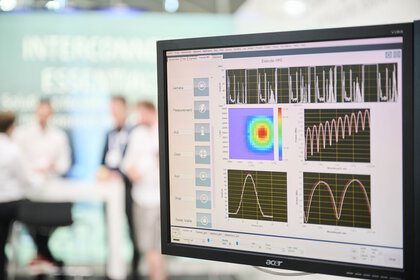Optical communication and information technology: data transmission of the future
The amounts of data generated across sectors is continuously growing, giving rise to challenges in transmission, processing and storage applications. The ever-expanding data transmission bandwidth now uses a tiny light particle, a photon, to carry what is now more relevant than ever: information.
Optical communication technology—the backbone of the digital world
Our information society produces staggering amounts of data while growth rates keep soaring beyond imagination: While the total volume of digital data according to statista.com was 16.1 zettabytes in 2016, the prognosis for 2025 is a volume of 163 zettabytes. According to this, today’s massive data volume will increase more than tenfold. Without the unprecedented transmission capacities of optical information technology, there would be no way to meet these exploding capacity requirements.
Optical communication technology uses light, or more precisely photons, to transmit huge amounts of data efficiently and with low loss. It forms the basis for the digital networking of our world—from fiber optic internet to data centers and global communication networks. In times of rapidly growing data volumes—from 16.1 zettabytes in 2016 to an estimated 163 zettabytes by 2025—it is indispensable. These challenges can only be overcome with the enormous transmission capacities of optical systems. That makes optical communication a key technology in the information society and essential for our digital future.

Optical communication and information technology: data transmission of the future
Optical components and media for data transmission have some significant advantages over their electrical counterparts: Compared to copper cables, the utilization of fiber optic cables is easier, more flexible and needs less space while it lowers the fire risk due to reduced heat generation. The almost unlimited bandwidth of fibre optical applications (80 Tbit/sec) surpasses electrical transmission (50 Mbit/sec) many times over. In addition to that, multiple independent data channels can be transmitted over vast distances with low losses..








Laser World of Photonics: the trade fair for optical information and communication
Apart from fibre optical applications, lasers for data transmission are relevant as well: Again, it is photons that enable communication, however, there is no use of fiber optic cables or other optical waveguides. Optical free space transmission is an example of a very flexible, wireless and tap-proof method of data transmission that is already being used by militaries, authorities, banks and other organizations. This technology only requires a clear line of sight and a distance within range. This technology has even proven effective for satellite communication in space.
However, new developments in the field of optical information technology do not stop there. They consistently drive progress with innovative ideas and pioneering efforts. The potential for future applications is enormous.

Product index
The Laser World of Photonics product index is a helpful range of exhibits according to product groups covering, among others, the following areas:
- Fibers, cabling, connectors and distribution
- Active and passive optical components and sub-systems
- Fiber-optic test and measurement
- Process and assembly equipment for fiber-optic applications
Exhibitor directory
The Laser World of Photonics exhibitor list is ideal for looking up specific information on any exhibitor.
Experience optical communication live—at Laser World of Photonics
Shaping the future now—with optical communication at Laser World of Photonics 2025.
In an age of exponentially growing data volumes, optical components, fiber optic technologies, and information systems are indispensable for our connected world. Laser World of Photonics 2025 is once again addressing this key topic as a central future field and offering you the ideal stage to present innovations, make new business contacts and drive progress together with leading minds from industry and research. Seize your chance to become part of the global platform for optical communication—where ideas become visible and new partnerships emerge!

Photonics industry portal & Newsletter
Explore the latest trends and innovations in the photonics industry. Our industry portal provides insights, expert interviews, and current news you won't want to miss.
Stay regularly informed about the most important and latest news in the field of photonics with our newsletter.
FAQ – the most important facts about optical communication technology in brief
Optical communication uses light, usually via optical fibers, for the fast and low-loss transmission of large amounts of data. It is the basis of modern internet, telecommunications and data center infrastructures.
Fiber optic transmission offers significantly higher bandwidths, lower signal losses, and better interference immunity, and is more efficient at bridging long distances.
In internet backbones, data centers, 5G networks, satellite communication, high-speed exchanges, medical technology (image transmission), autonomous vehicles, and more.
Photonic chips integrate optical components such as lasers, detectors and modulators on a single chip. They enable extremely fast data processing and transmission – in an energy-efficient manner and with high packing density.
The trade fair is showing the latest developments in fiber optic and optical network technology, integrated photonics and photonic components for telecommunications and data infrastructure.
The current trends include:
- Integrated silicon photonics
- Photonic chips for AI and the cloud
- Energy-saving light modulation
